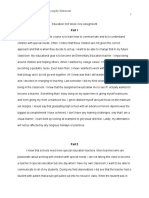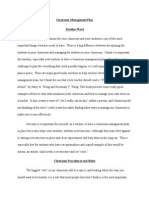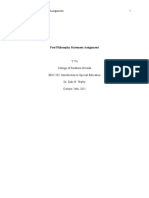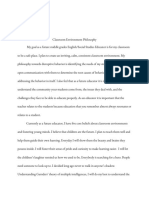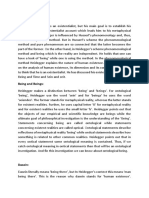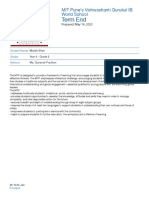English Position Paper
English Position Paper
Uploaded by
api-302583371Copyright:
Available Formats
English Position Paper
English Position Paper
Uploaded by
api-302583371Original Title
Copyright
Available Formats
Share this document
Did you find this document useful?
Is this content inappropriate?
Copyright:
Available Formats
English Position Paper
English Position Paper
Uploaded by
api-302583371Copyright:
Available Formats
Vargas 1
Christina Vargas
Professor Ogbara
English 1A, #72531
21 September 2015
The Odd Absence of Critical Thinking in Schools
Although critical thinking is an important skill which students should aim to acquire in
school, it is a skill that many students have actually found difficult to acquire in school. As a
matter of fact, a number of students do not know how to think critically. Social media and
networking, celebrity obsession, movies and television, etc. can and have contributed to this
difficulty in critical thinking which some students have experienced in todays age and time.
While these contributions have played their part in creating a barrier between students and
critical thinking, these expected contributions are not the only contributions which can hold
students from the ability to think critically. In her essay, Critical Thinking, educator and
activist, bell hooks, claims that children are born as critical thinkers but that as they grow up,
they are taught to cease their critical thinking. She states that while students need to be engaged
for critical thinking to occur, the teachers also need to be engaged and open to new possibilities.
Similarly, in his essay, Thinking in Education, philosopher and educator, John Dewey, reasons
that students are unable to think critically in their classrooms. He suggests that teachers need to
create an environment in their classrooms that encourages students to think critically. Instead of
using mock problems, the teachers should provide genuine problems. If teachers did this, it
would improve critical thinking and more specifically, it would also help to dissipate the barrier
between the skills which students learn in their classrooms and their ability to connect these
skills to real life problems which they might encounter throughout their lifetime. Critical
Vargas 2
thinking needs to be established within students minds, yet it scarcely exists within their minds
and this is a problem and will continue to be a problem for these individuals as they continue on
through life even after they finish studying in a classroom. Both students and teachers need to be
making an effort to enforce critical thinking in classrooms so that students may carry these
necessary life skills with them throughout the rest of their time on Earth.
A pupil has a problem, but it is the problem of meeting the peculiar requirements set by
the teacher. (Dewey, page 561). One obstacle between students and critical thinking is that most
teachers provide their students with busy work. The challenge with this decision is that while it
may help the teacher to know which students are participating and which students are not,
students do not actually learn anything from busy work. Doing busy work does not require one to
think. Unfortunately, busy work does require the students to put time into the completion of this
busy work. This time that students are required to invest in their busy work is time that is being
taken away from thinking. As Dewey tells us in Thinking in Education, the goal of the students
is not learning. Instead, their goal is to please their instructor. This causes the assignments, also
known as busy work, to become nothing more than the tasks which need to be completed in
order that the students may satisfy their teacher. When students forget how to think, they lose the
ability to connect skills learned in the classroom with skills required throughout real life. This
pathway between classroom skills which are learned and life skills which are used is necessary.
Therefore, an effort must be made so that students may understand the connection between these
two seemingly different concepts.
One way in which teachers could help students understand the connection between real
life problems and skills learned in the classroom is by providing assignments that are not simply
busy work. Assigning work that teaches students is not the extent of what teachers could do to
Vargas 3
help their students, however. In addition, teachers should assign work that creates genuine
problems and not mock problems. Of course if teachers are to assign work with genuine
problems, the teacher would be required to understand what genuine and mock problems are.
Currently, many problems that students are being assigned are irrelevant to their life. Instead, the
problems consist of seemingly random situations. One example I created was of a math teacher
asking his or her students to solve a math problem about two running cheetahs where the student
was required to find the cheetah which reached the destination first. As far as I know, no student
in a classroom has ever been a cheetah. Unfortunately, teachers assign many problems that are
very similar to the one which I just described. The contrasting example which I created was of
two friends racing each other to get to an ice cream shop first. Although this specific example
will not necessarily occur during an individuals life, it is easier to relate the second problem to a
situation in life which an individual may need to solve in his or her future. This skill is problem
solving and this can be considered a form of critical thinking.
A very common assignment for students which hinders critical thinking is the
memorization of facts. Every student that I have known has had to endure this task at some point
or another. When I think about this type of assignment, I wonder what students are supposed to
be learning from such an assignment. After all, the students whom I have spoken to did not learn
from this type of assignment. They memorized the facts, perhaps took a test about what they
memorized, and then forgot what they memorized. It seemed to me that this was not the most
effective method for learning. It has become a system for the students who apply themselves
now, though. For a number of students, these systematic habits have followed them into their
everyday life. I acknowledge that the need for systems which is evident in some people is not
completely the fault of the continuous use of systems at school. In fact, many people who attend
Vargas 4
a regular school do not even have a need for systems. I believe that there are different habits
which an individual may attain from school and that one of those is the need for systems. My
friend Kelli is one of those individuals who have an obsession with systems.
Once my friend Kelli, my other friend Charlotte, and I all went to Disneyland for my
birthday. Charlotte and I did not grow up in the regular school system and had no desire to
follow a system or schedule. My friend Kelli, however, was very insistent that we needed to go
to very specific rides by very specific times in a specific order. As you may be able to predict, we
got off her schedule and this caused her to begin hyperventilating. At another point, she went
ahead of our group to get in line for a ride and ended up going on the ride without Charlotte and
me because she feels that she cannot get off of her schedule. This was disappointing for me as we
had gone to Disneyland for the purpose of celebrating my birthday. Later she apologized and
reminded me of her seemingly inability to straw away from a schedule. I have talked to her about
her commitment to systems and she has expressed to me that she can explain her urgency to stick
to a schedule for no reason other than it is what she is familiar with and that she has grown up
with this type of habit. Understandably, there have been other instances throughout our
friendship where she has been unwilling to accept new concepts. As we have talked through the
years, she has implied to me through speech and actions that her need to have a system was
formed partially due to the systems at school.
Children are organically predisposed to be critical thinkers . . . Sadly, childrens passion
for thinking often ends when they encounter a world that seeks to educate them for conformity
and obedience only. (bell hooks, page 1). According to bell hooks, children are born to be
critical thinkers. As they grow up, however, they are taught to conform to the standards which
adults hold. I do not believe that these individuals lose their ability to think critically. Instead, I
Vargas 5
believe that they forget how to think critically. They are taught by their parents and by schools to
be obedient and not to speak their mind. This becomes a habit for the students after so many
years and when a skill is not practiced, it becomes weak and often forgotten. I believe this is the
situation which many students fall prey to. Therefore, schools should not attempt to prevent
students from thinking critically simply so that they may obey rules. Instead, they should
encourage students to develop their own perspective and still to be obedient.
Another problem which bell hooks points out is that many teachers have the idea that
they must be right at all times. When a teacher cannot admit that he or she is wrong, this
instructor is being narrow minded as he or she is not accepting any other thoughts as even
possibilities. Unfortunately, this narrow minded perspective which a teacher might hold will not
only affect the teacher as an individual. In addition, this type of perspective will also affect his or
her students and it is very likely that the teachers affect will mold these students into narrow
minded individuals as well. This is why bell hooks instructs teachers to be open minded and to
be willing to acknowledge the fact that there are things which a teacher does not know. When a
teacher is open minded, the teacher will be receptive to new ideas, including the ideas which a
student may propose. This receptiveness towards the student and the students ideas is an ideal
situation as it encourages the student to begin thinking critically again. People seek affirmation
and receiving affirmation from an authoritative figure is encouraging for many individuals. This
is another reason why students may value the receptiveness which a teacher may gift his or her
students.
It is not solely the responsibility of the teacher to create an environment where critical
thinking is encouraged, however. Students have to be willing to be engaged as well as the
teachers. Most people are not willing to step outside of their comfort zones. After growing up
Vargas 6
with the concept that critical thinking is dangerous, most students would prefer not to meddle
with the possibility of critical thinking. It is simply more comfortable and it is easier to continue
doing and saying things that they are familiar with. If these students wish to have the ability to
create a thought for their own selves and to be able to think away from the books, these students
will need to step out of their comfort zones. Until students can become responsible enough to
take such an uncomfortable step away from what they know, they will continue to live within
their little bubble and will also continue to live dependently on what they hear and read.
Some people may argue that schools promote critical thinking through the various papers
which are assigned to students. They state that these papers enhance critical thinking as the
students must think to be able to respond to prompts. They may also argue that critical thinking
is practiced daily as people engage in tasks as simple as deciding what to make for dinner or
selecting their clothes for the day. John Dewey, my friend Kelli, and bell hooks, on the other
hand, have all given me more reason to believe that school discourages critical thinking in
actuality. Examples such as Deweys claims that students lack a pathway between critical
thinking and themselves, my friend Kellis inability to stray away from systems, and bell hooks
arguments that school creates an environment which discourages the critical thinking which
children were born with all lead me to the same conclusion. There was an absence of critical
thinking in schools from before and there is still an absence of critical thinking in schools today.
You might also like
- Living and Leading in A VUCA World - Thunderbird SchoolDocument4 pagesLiving and Leading in A VUCA World - Thunderbird SchoolPetra Fejes100% (2)
- Organization and Management SyllabusDocument4 pagesOrganization and Management SyllabusFelix Salonga100% (4)
- AN ACTION PLAN IN HANDLING APATHETIC STUDENTS, John Mark H. AlbertoDocument4 pagesAN ACTION PLAN IN HANDLING APATHETIC STUDENTS, John Mark H. Albertodeden08No ratings yet
- Untitled documentDocument5 pagesUntitled documenthavenleigh123No ratings yet
- Classroom Managment Plan 2Document14 pagesClassroom Managment Plan 2api-509849143No ratings yet
- Identity PaperDocument7 pagesIdentity Paperapi-305604218No ratings yet
- Artifact 1 Educational PhiloshopyDocument5 pagesArtifact 1 Educational Philoshopyapi-635562745No ratings yet
- Edu221 Philosophy PaperDocument6 pagesEdu221 Philosophy Paperapi-535069797No ratings yet
- Reflection On Fred Jones William Glasser and Rudolf DreikursDocument3 pagesReflection On Fred Jones William Glasser and Rudolf Dreikursapi-340096521100% (2)
- Field Hours - Observation LogDocument4 pagesField Hours - Observation Logapi-656454154No ratings yet
- Ed698 1 333Document6 pagesEd698 1 333api-664166199No ratings yet
- Personal Teaching Philosophy by Bryan CruzDocument6 pagesPersonal Teaching Philosophy by Bryan Cruzapi-357292404No ratings yet
- Textbook Reading Accountability Form 2016Document7 pagesTextbook Reading Accountability Form 2016api-311038486No ratings yet
- Edu 203 Pre-PhilosophyDocument3 pagesEdu 203 Pre-Philosophyapi-511161323No ratings yet
- Sel ProjectDocument15 pagesSel Projectapi-607899432No ratings yet
- Vision of My Future ClassroomDocument12 pagesVision of My Future Classroomapi-606267561No ratings yet
- PART B Model of InstructionsDocument6 pagesPART B Model of InstructionsAmirudinHashimNo ratings yet
- Restore YouthDocument10 pagesRestore Youthapi-317162113No ratings yet
- PhilosophyDocument2 pagesPhilosophyapi-272219855No ratings yet
- Artifact 3 - Course Reflection - Cep891 Summer 2014Document6 pagesArtifact 3 - Course Reflection - Cep891 Summer 2014api-315333936No ratings yet
- Lesson Plan On Pakistan MovementDocument32 pagesLesson Plan On Pakistan MovementMuhammad Noor Ul Huda0% (2)
- Video TranscriptionDocument10 pagesVideo TranscriptionQueeny JamesNo ratings yet
- Informed Beliefs PaperDocument11 pagesInformed Beliefs Paperapi-743161032No ratings yet
- Statement of Informed BeliefsDocument9 pagesStatement of Informed Beliefsapi-576887653No ratings yet
- Katelyn Ward - Classroom Management PaperDocument5 pagesKatelyn Ward - Classroom Management Paperapi-264880763No ratings yet
- Philosophy PaperDocument7 pagesPhilosophy Paperapi-335100458No ratings yet
- How To Teach A Young IntrovertDocument6 pagesHow To Teach A Young IntrovertFlorentina SuduNo ratings yet
- The Success in Teaching A Foreign Language Is MotivationDocument4 pagesThe Success in Teaching A Foreign Language Is MotivationPopa NadiaNo ratings yet
- Theory To PracticeDocument5 pagesTheory To Practiceapi-438077863No ratings yet
- PhilosophyDocument6 pagesPhilosophyapi-5811714090% (1)
- Post Philosophy Statement AssignmentDocument5 pagesPost Philosophy Statement Assignmentapi-608485727No ratings yet
- Capstone Research PaperDocument17 pagesCapstone Research Paperapi-544921626No ratings yet
- Psych FinalDocument6 pagesPsych Finalapi-245810041100% (1)
- What Does Good Teaching Look Like?Document11 pagesWhat Does Good Teaching Look Like?fojanpri100% (1)
- Tuning Protocol Maddie Bartlett 1Document27 pagesTuning Protocol Maddie Bartlett 1api-741712394No ratings yet
- Ued 480a Ortiz Deziree Child Adolescent DevelopmentDocument7 pagesUed 480a Ortiz Deziree Child Adolescent Developmentapi-539145024No ratings yet
- Ed 692 - Goal One - FlanaganDocument7 pagesEd 692 - Goal One - Flanaganapi-296446877No ratings yet
- Discussions To Reply ToDocument6 pagesDiscussions To Reply ToandyNo ratings yet
- Jesus Gonzalez SED 322 Signature Assignment Engagement in The ClassroomDocument8 pagesJesus Gonzalez SED 322 Signature Assignment Engagement in The Classroomapi-396012164No ratings yet
- Classroom Management Plan and ScriptDocument19 pagesClassroom Management Plan and Scriptapi-302270555No ratings yet
- A Positive Classroom Environment Josh Fish Grand Valley State University EDI 638Document8 pagesA Positive Classroom Environment Josh Fish Grand Valley State University EDI 638api-354116390No ratings yet
- NewsletterDocument7 pagesNewsletterapi-265307177No ratings yet
- Educational Philosophy FinalDocument5 pagesEducational Philosophy Finalapi-403386868No ratings yet
- Teaching Strategies to Motivate College StudentsFrom EverandTeaching Strategies to Motivate College StudentsRating: 5 out of 5 stars5/5 (2)
- Philosophical Portrait of MyselfDocument3 pagesPhilosophical Portrait of Myselfapi-356846284No ratings yet
- Field Exp-Part 3Document3 pagesField Exp-Part 3api-511512490No ratings yet
- Positionality PaperDocument3 pagesPositionality Paperapi-243860050No ratings yet
- Classroom Managment Plan 12-16Document11 pagesClassroom Managment Plan 12-16api-242984358No ratings yet
- PhilosophyofeduDocument6 pagesPhilosophyofeduapi-356316407No ratings yet
- Classroom Environment Philosophy - RevDocument7 pagesClassroom Environment Philosophy - Revapi-710728234No ratings yet
- Digital Portfolio Project - Part IDocument6 pagesDigital Portfolio Project - Part Iapi-276580201No ratings yet
- Motivation: The Steps Towards It and What Strategies To Use Angela Rosales SED 3301 Dr. Anjoo Sikka Motivation PaperDocument14 pagesMotivation: The Steps Towards It and What Strategies To Use Angela Rosales SED 3301 Dr. Anjoo Sikka Motivation Paperjune060890No ratings yet
- My Philosophy of Educating Exceptional LearnersDocument5 pagesMy Philosophy of Educating Exceptional Learnersapi-254115404No ratings yet
- TLED 435-Democratic ClassroomDocument5 pagesTLED 435-Democratic ClassroomShakia MOSLEYNo ratings yet
- Philosophy of LearningDocument4 pagesPhilosophy of Learningapi-735113072No ratings yet
- k453 Classroom Management PlanDocument16 pagesk453 Classroom Management Planapi-159128275No ratings yet
- What Are The Advantages and Disadvantages of School Education and Family Education?Document31 pagesWhat Are The Advantages and Disadvantages of School Education and Family Education?Sanjay SahooNo ratings yet
- According To Evertson and WeinsteinDocument4 pagesAccording To Evertson and WeinsteinkirubahNo ratings yet
- Sib Essay 1Document12 pagesSib Essay 1api-744988181No ratings yet
- Final Statement of Informed Beliefs PaperDocument10 pagesFinal Statement of Informed Beliefs Paperapi-637505337No ratings yet
- Proposal For ChangeDocument17 pagesProposal For Changeapi-426091669No ratings yet
- Apa Utopia PaperDocument16 pagesApa Utopia Paperapi-513013924No ratings yet
- Emotional Support AnimalDocument4 pagesEmotional Support AnimalFhilQuinto100% (2)
- Cami OriginalDocument22 pagesCami OriginalSantiago OsorioNo ratings yet
- Case DigestDocument3 pagesCase DigestErika LapitanNo ratings yet
- Online Observation of Lesson Observation No: 7: Teacher Qualities Rank Out of 5 Detail Description of QualitiesDocument4 pagesOnline Observation of Lesson Observation No: 7: Teacher Qualities Rank Out of 5 Detail Description of QualitiesPrachi SharmaNo ratings yet
- The Prevalence of Mental Health Problems in Elite AthletesDocument7 pagesThe Prevalence of Mental Health Problems in Elite AthletesPaper PlaneNo ratings yet
- The Filipino Core ValuesDocument3 pagesThe Filipino Core ValuesBiacora Manalo HerculesNo ratings yet
- TOPIC 3 Ability Disability As A Dimension of DiversityDocument2 pagesTOPIC 3 Ability Disability As A Dimension of DiversityjanedecilosNo ratings yet
- Thought Pollution - Root Cause of All IllsDocument1 pageThought Pollution - Root Cause of All IllsSuhani JamwalNo ratings yet
- Why Is Yawning Contagious?Document3 pagesWhy Is Yawning Contagious?NicaEalaNo ratings yet
- The Cornell Scale For Depression in DementiaDocument12 pagesThe Cornell Scale For Depression in DementiaPopa NiculinaNo ratings yet
- Using Positive Constructive Daydreaming (PCD)Document2 pagesUsing Positive Constructive Daydreaming (PCD)Tugonon M Leo RoswaldNo ratings yet
- Johnson Donohue Business Communication 1994Document14 pagesJohnson Donohue Business Communication 1994Athirah Rerana FitrianthyNo ratings yet
- Stress, Coping, and HopeDocument9 pagesStress, Coping, and HopeMeriem AnsariNo ratings yet
- MARTIN HEIDEGGER Avinash SinhaDocument8 pagesMARTIN HEIDEGGER Avinash SinhachutiyapNo ratings yet
- Informal ProposalDocument2 pagesInformal ProposalMiguel BulanteNo ratings yet
- Evaluating MYP Unit PlansDocument23 pagesEvaluating MYP Unit PlansLorraine SabbaghNo ratings yet
- Term EndDocument23 pagesTerm EndMoksh ShahNo ratings yet
- LS Sample 1Document202 pagesLS Sample 1riddhiNo ratings yet
- Last Dtl-Assessement-Final-VerDocument10 pagesLast Dtl-Assessement-Final-Verapi-369236178No ratings yet
- Assignment 1 - Soc 1010Document3 pagesAssignment 1 - Soc 1010api-313425276No ratings yet
- Guidelines For Assignment 3Document2 pagesGuidelines For Assignment 3SamNo ratings yet
- A Psychological and Philosophical Understanding of Death - An AnaDocument60 pagesA Psychological and Philosophical Understanding of Death - An AnanaomiNo ratings yet
- Munar, Mark Francis E. Summer Final ExamDocument15 pagesMunar, Mark Francis E. Summer Final ExamMark Francis MunarNo ratings yet
- ObjectivesDocument4 pagesObjectivesJov SoyomNo ratings yet
- Weeks 1 2 3: Practice Teaching EvaluationDocument2 pagesWeeks 1 2 3: Practice Teaching Evaluationapi-244894096No ratings yet
- Disciplines and Ideas in The Applied Social Sciences Quarter 3: Weeks 3&4 MELC: Describe The Clientele of CounselingDocument12 pagesDisciplines and Ideas in The Applied Social Sciences Quarter 3: Weeks 3&4 MELC: Describe The Clientele of CounselingSharon May JavierNo ratings yet
- Mental Health of Junior and Senior High School Students of Colegio de San Bartolome de Novaliches During PandemicDocument13 pagesMental Health of Junior and Senior High School Students of Colegio de San Bartolome de Novaliches During PandemicwittyanabelbembemNo ratings yet
- Training and Management in OrganizationDocument24 pagesTraining and Management in OrganizationZeeshanNo ratings yet













